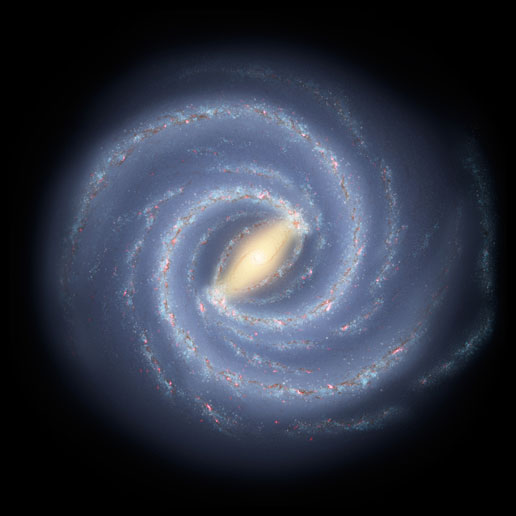Physicists look for dark matter
95% - that's the part of the universe missed. It's like it doesn't exist. Or at least, if it exists, we can't see it. We call it 'dark matter'.
This has long been recognized. But the bigger question is 'why'. Why is 95% of the universe formed from what is called 'dark matter'? And the bigger question is 'where'. Where does dark matter exist? Those are the two questions that have long been a physicist's head. Dark matter, as its name suggests, is a material that cannot be seen. So how do we observe them, how do we know where to look for them?
For centuries, physicists have tried to think of indirect ways to observe dark matter. Now the team of scientists at the Princeton Research Institute, NJ and the Max Planck Institute for Physics Research in Munich are ready to test their methods - news from the Economist.
Although we have not been able to see dark matter yet, it still exists. Why is it so affirmed? Galaxies rotate at such high speeds that if there is no force keeping them in place, they will move chaotic everywhere. And the name of this resource is Dark Matter. However, it is likely that in the near future, this material will no longer be in the 'dark' form - at least at the atomic scale, where a group of physicists have collected early evidence. First.
Evidence is high energy positrons in the universe. As is known, positrons are antimatter forms of electrons. Some theorists argue that they are formed through the mutual impact of WIMPs. WIMPs are slightly interacting large particles, which are a form of dark matter.Physicists have calculated that positrons are a product of interaction between WIMP and anti-WIMP .
 Galaxy. (Photo: NASA / JPL-Caltech)
Galaxy. (Photo: NASA / JPL-Caltech)
Dr. Michael Kuhlen has been working on this issue for a long time. Now he has the basis to believe this hypothesis. Kuhlen and his colleagues built a computer model of the ring of dark matter surrounding the Milky Way. Kuhlen brings us back in time to 50 million years after the Big Bang. This is the time when the first galaxies formed. From this point Kuhlen's team calculated the interaction of one billion WIMPs over the next 13.7 billion years.
In this model, Kuhlen also uses the Sommerfeld effect. This effect was proposed by German physicist Arnold Sommerfeld in the 1030s, which had a quantum mechanical process that made the particles interact with each other in certain conditions and less in the other lawsuit.The model shows that with this effect, dark matter will destroy each other more easily than people think. The Kuhlen team has published the results of the latest study in Science.
If Kuhlen's conclusion is correct, they will explain the apparent existence of high-energy positrons. They will also find a second signal from the decaying dark matter. They will exist as gamma rays emanating from the Milky Way. Satellite telescopes, such as Fermi, will catch them easily.
On the other half of the Earth, Pierre Colin of Max Planck Institute of Physics, Munich is using a completely different way to solve the same problem. While Kuhlen refers to the entire Milky Way, Colin is interested in a very small part of this galaxy. Colin and his colleagues believed in using the moon's shadow to detect whether positrons actually came from opposing dark matter particles.They are using telescopes to search for Cherenkov radiation created when cosmic rays touch the Earth's upper atmosphere.
On July 9, Dr. Colin presented his research content at the International Cosmic Ray Conference held in Lodz, Finland. He pointed out that the moon interferes with electrons and positrons in a way that obstructs light producing positron and electron dark regions. However, since these particles carry energy, they also interact with the Terran magnetic field. This interaction separates two types of particles in two different directions because they have opposite energies.
This creates individual electron and positron dark regions. It is often impossible to distinguish Cherenkov radiation generated by positron particles and radiation generated by electron particles, but Colin still thinks it can be done. Ngta can do this by observing the edges of the dark areas when the moon is between the telescope and the cosmic ray source. In this way they will determine whether high-energy positrons match the theoretical values. And they will get dark matter out of the dark.
- New explanation of the origin of dark matter
- Discover the existence of dark material?
- 11 mysteries about dark matter have not been answered yet
- Found signs of dark matter
- Revealing the first image of dark matter
- The race to find dark matter is heating up
- Earth is losing dark matter
- The mystery of dark matter has been decoded?
- The first image of the dark matter network, which connects galaxies together
- Limit on the size of dark matter blocks
- Detecting dark matter fibers
- Interesting new technology helps explore dark matter
 Van Allen's belt and evidence that the Apollo 11 mission to the Moon was myth
Van Allen's belt and evidence that the Apollo 11 mission to the Moon was myth The levels of civilization in the universe (Kardashev scale)
The levels of civilization in the universe (Kardashev scale) Today Mars, the sun and the Earth are aligned
Today Mars, the sun and the Earth are aligned The Amazon owner announced a secret plan to build a space base for thousands of people
The Amazon owner announced a secret plan to build a space base for thousands of people